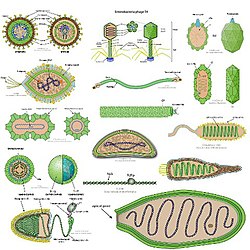Non-cellular life
Overview of non-cellular life forms
Non-cellular life[edit]

Non-cellular life refers to biological entities that exist without a cellular structure. These entities are primarily composed of viruses, viroids, prions, and other similar agents. Unlike cellular life forms, non-cellular life does not have the typical characteristics of living organisms, such as cellular organization, metabolism, and the ability to reproduce independently.
Viruses[edit]
Viruses are the most well-known form of non-cellular life. They are composed of genetic material, either DNA or RNA, encased in a protein coat called a capsid. Some viruses also have an outer lipid envelope. Viruses are obligate intracellular parasites, meaning they can only replicate inside the living cells of an organism. They infect all types of life forms, from animals and plants to microorganisms, including bacteria and archaea.
Viroids[edit]
Viroids are small, circular RNA molecules that infect plants. Unlike viruses, viroids do not have a protein coat. They are capable of autonomous replication within the host cell and can cause various plant diseases. Viroids are the smallest known infectious agents and are composed solely of a short strand of circular, single-stranded RNA.
Prions[edit]
Prions are infectious agents composed entirely of protein. They are responsible for a variety of neurodegenerative diseases in animals and humans, such as Creutzfeldt-Jakob disease and bovine spongiform encephalopathy (mad cow disease). Prions propagate by inducing normal, cellular proteins to adopt the abnormal prion form, which then accumulates in the brain and leads to disease.
Other non-cellular entities[edit]
In addition to viruses, viroids, and prions, there are other non-cellular entities that challenge the traditional definitions of life. These include satellite viruses, which depend on helper viruses for replication, and plasmids, which are small DNA molecules within cells that are physically separated from chromosomal DNA and can replicate independently.
Characteristics of non-cellular life[edit]
Non-cellular life forms share several characteristics that distinguish them from cellular organisms:
- Lack of cellular structure: They do not have a cell membrane or organelles.
- Dependence on host cells: They require a host cell to replicate and propagate.
- Simple composition: They are composed of genetic material and, in some cases, proteins, but lack the complex structures found in cellular life.
- Diverse replication strategies: They employ various mechanisms to hijack the host's cellular machinery for replication.
Related pages[edit]
Ad. Transform your life with W8MD's Budget GLP-1 injections from $75


W8MD offers a medical weight loss program to lose weight in Philadelphia. Our physician-supervised medical weight loss provides:
- Weight loss injections in NYC (generic and brand names):
- Zepbound / Mounjaro, Wegovy / Ozempic, Saxenda
- Most insurances accepted or discounted self-pay rates. We will obtain insurance prior authorizations if needed.
- Generic GLP1 weight loss injections from $75 for the starting dose.
- Also offer prescription weight loss medications including Phentermine, Qsymia, Diethylpropion, Contrave etc.
NYC weight loss doctor appointmentsNYC weight loss doctor appointments
Start your NYC weight loss journey today at our NYC medical weight loss and Philadelphia medical weight loss clinics.
- Call 718-946-5500 to lose weight in NYC or for medical weight loss in Philadelphia 215-676-2334.
- Tags:NYC medical weight loss, Philadelphia lose weight Zepbound NYC, Budget GLP1 weight loss injections, Wegovy Philadelphia, Wegovy NYC, Philadelphia medical weight loss, Brookly weight loss and Wegovy NYC
|
WikiMD's Wellness Encyclopedia |
| Let Food Be Thy Medicine Medicine Thy Food - Hippocrates |
Medical Disclaimer: WikiMD is not a substitute for professional medical advice. The information on WikiMD is provided as an information resource only, may be incorrect, outdated or misleading, and is not to be used or relied on for any diagnostic or treatment purposes. Please consult your health care provider before making any healthcare decisions or for guidance about a specific medical condition. WikiMD expressly disclaims responsibility, and shall have no liability, for any damages, loss, injury, or liability whatsoever suffered as a result of your reliance on the information contained in this site. By visiting this site you agree to the foregoing terms and conditions, which may from time to time be changed or supplemented by WikiMD. If you do not agree to the foregoing terms and conditions, you should not enter or use this site. See full disclaimer.
Credits:Most images are courtesy of Wikimedia commons, and templates, categories Wikipedia, licensed under CC BY SA or similar.
Translate this page: - East Asian
中文,
日本,
한국어,
South Asian
हिन्दी,
தமிழ்,
తెలుగు,
Urdu,
ಕನ್ನಡ,
Southeast Asian
Indonesian,
Vietnamese,
Thai,
မြန်မာဘာသာ,
বাংলা
European
español,
Deutsch,
français,
Greek,
português do Brasil,
polski,
română,
русский,
Nederlands,
norsk,
svenska,
suomi,
Italian
Middle Eastern & African
عربى,
Turkish,
Persian,
Hebrew,
Afrikaans,
isiZulu,
Kiswahili,
Other
Bulgarian,
Hungarian,
Czech,
Swedish,
മലയാളം,
मराठी,
ਪੰਜਾਬੀ,
ગુજરાતી,
Portuguese,
Ukrainian